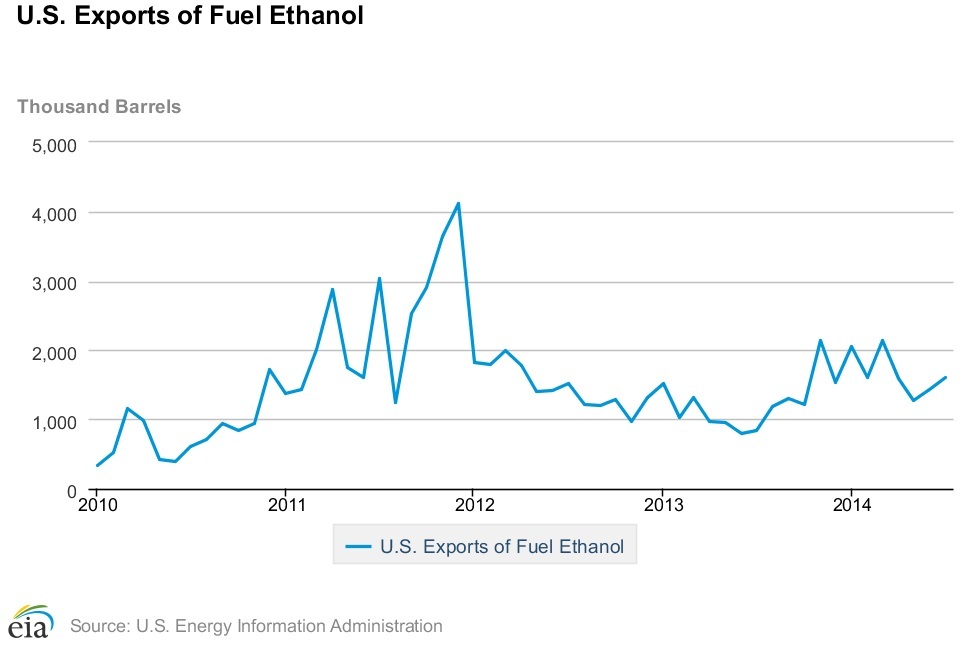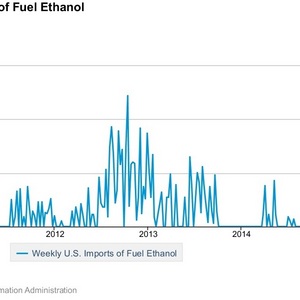Record corn use for ethanol reported for 2013-'14 marketing year



U.S. Energy Information Administration
October 6, 2014
BY Susanne Retka Schill
Ethanol production for the corn-marketing year just ended (September through August) reached a record 14.15 billion gallons, using a record 5.125 billion bushels of corn, according to a data analysis by University of Illinois economist Darrel Good in a FarmDocDaily posting, “Big Year for Ethanol.” The ethanol production during those 12 months was 1.3 billion gallons more than the previous marketing year and 354 million gallons more than the previous record production during the 2011-’12 corn marketing year.
In his analysis, Good reviewed domestic ethanol production, reported monthly by the U.S. Energy Information Administration. Normally reported on a calendar year basis, Good analyzed the data on a corn marketing year basis to coincide with the USDA’s reporting of corn supply and demand.
Advertisement
He went on to look at monthly Census Bureau estimates of ethanol exports and imports: “Ethanol imports during the 2013-’14 marketing year are estimated at 275 million gallons, 509 million gallons less than imported during the previous year when domestic ethanol production was limited by a short supply and high price of corn,” Good reported. Most of those imports were from Brazil. And, while ethanol exports were 788 million gallons, up 227 million gallons from the previous year, the total was still nearly 300 million gallons less than the 2011-’12 marketing year. “Exports were exceptionally large in 2011-’12 resulting from a sharp decline in Brazilian ethanol production due to a small supply and high price of sugar,” he explained. With the exception of that year, Canada is the largest U.S. ethanol customer.
Domestic stocks of ethanol increased an estimated 35 million gallons during the corn marketing year just closed, compared to the previous year’s decline of 94 million gallons. “The estimates of production, imports, exports, and stocks imply that domestic consumption of ethanol during the 2013-’14 marketing year totaled 13.6 billion gallons, 443 million gallons more than the previous record consumption in 2012-’13,” Good said. “The three percent increase in consumption was supported by a modest increase in motor fuel consumption and a modest increase in consumption of higher ethanol blends, primarily E85.”
Advertisement
Noting that increased ethanol production brings with it increased distillers grains production, Good looked at the feed coproduct’s numbers as well. “The Census Bureau estimates that 13.2 million tons of distillers' grains were exported during the 2013-’14 marketing year, about 50 percent more than in each of the previous two years,” he wrote. “China was the largest importer of distillers' grains, followed by Mexico.” Chinese restrictions on the import of some genetically modified corn products has raised concerns about exports to China, he added. “Smaller Chinese imports could alter the mix of feed ingredients consumed, but it would not likely alter the global demand for total feed ingredients.”
“With a record large U.S. corn crop this year, the magnitude of ethanol production will be important in determining the extent of the build-up in domestic corn inventories by the end of the current marketing year,” Good concluded. “With only limited potential for growth in domestic ethanol consumption, expansion in production will be dependent on continued small or declining imports and growth in exports of ethanol. Export potential is enhanced by the current low price of ethanol relative to gasoline, but increases are not yet evident in monthly Census Bureau export estimates.”
Related Stories
CountryMark on July 22 celebrated the completion of more than $100 million in upgrades at its refinery in Indiana, including those related to soybean oil storage. The facility produces renewable diesel via coprocessing technology.
ATOBA Energy and Air Moana are partnering to implement scalable solutions for the supply of SAF. The collaboration aims to ensure long-term SAF availability while supporting local initiatives to develop sustainable fuel production in Tahiti.
Neste Corp. on July 24 released second quarter results, reporting record quarterly renewable product sales volumes despite weaker margins. SAF sales were up nearly 80% when compared to the first quarter of 2025.
Valero Energy Corp. on July 24 released second quarter results, reporting a profitable three-month period for its ethanol segment. The renewable diesel segment posted a loss, but the company’s new sustainable aviation fuel (SAF) unit operated well.
The IRS on July 21 published a notice announcing the 2025 calendar-year inflation adjustment factor for the Section 45Z clen fuel production credit. The resulting adjustment boosts maximum the value of the credit by approximately 6%.
Upcoming Events










